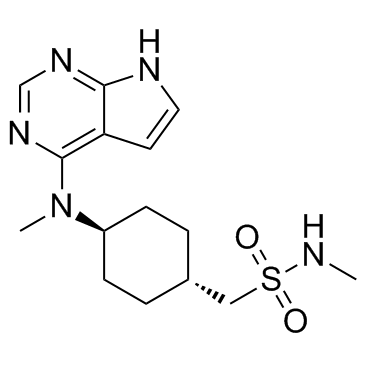Oclacitinib
Modify Date: 2025-08-25 17:19:10

Oclacitinib structure
|
Common Name | Oclacitinib | ||
|---|---|---|---|---|
| CAS Number | 1208319-26-9 | Molecular Weight | 337.440 | |
| Density | 1.3±0.1 g/cm3 | Boiling Point | N/A | |
| Molecular Formula | C15H23N5O2S | Melting Point | N/A | |
| MSDS | N/A | Flash Point | N/A | |
Use of OclacitinibOclacitinib is a novel JAK inhibitor. Oclacitinib is most potent at inhibiting JAK1 (IC50=10 nM). |
| Name | Oclacitinib |
|---|---|
| Synonym | More Synonyms |
| Description | Oclacitinib is a novel JAK inhibitor. Oclacitinib is most potent at inhibiting JAK1 (IC50=10 nM). |
|---|---|
| Related Catalog | |
| Target |
JAK1:10 nM (IC50) JAK2:18 nM (IC50) Tyk2:84 nM (IC50) JAK3:99 nM (IC50) |
| In Vitro | Using isolated enzyme systems and in vitro human or canine cell models, potency and selectivity of Oclacitinib is determined against JAK family members and cytokines that trigger JAK activation in cells. Inhibitory activity of Oclacitinib against JAK family members is determined in isolated enzyme systems. Oclacitinib inhibits JAK1, JAK2, JAK3, and TYK2 by 50% at concentrations (IC50's) of 10, 18, 99, and 84 nM, respectively. Oclacitinib is most potent against the JAK1 enzyme, showing a 1.8-fold selectivity for JAK1 vs. JAK2 and 9.9-fold selectivity toward JAK1 vs. JAK3. Oclacitinib inhibits JAK family members by 50% at concentrations (IC50's) ranging from 10 to 99 nM and does not inhibit a panel of 38 non-JAK kinases (IC50's > 1000 nM). Oclacitinib also inhibits the function of JAK1-dependent cytokines involved in allergy and inflammation (IL-2, IL-4, IL-6, and IL-13) as well as pruritus (IL-31) at IC50's ranging from 36 to 249 nM. Oclacitinib has minimal effects on cytokines that does not activate the JAK1 enzyme in cells (erythropoietin, granulocyte/macrophage colony-stimulating factor, IL-12, IL-23; IC50's > 1000 nM) [1].Topical treatment with Tofacitinib (0.1%) and Oclacitinib (0.1%) leads to significant reduction of cell migration from mouse ear explants compared with vehicle-treated ears (all P < 0.05). The cell counts of MHC class II positive cells (that is, Langerhans cells) are significantly lower in vehicle-treated compared with each JAK inhibitor–treated epidermis (all P < 0.01) [2]. |
| In Vivo | Scratching bouts at the high dose in the Oclacitinib group are significantly less than in the vehicle-only group (P<0.01)[2]. Client-owned dogs (n=436) with moderate to severe owner-assessed pruritus and a presumptive diagnosis of allergic dermatitis are enrolled. Dogs are randomized to either Oclacitinib at 0.4-0.6 mg/kg orally twice daily or an excipient-matched placebo. An enhanced 10 cm visual analog scale (VAS) is used to assess the severity of pruritus from day 0 to 7 and to assess the severity of dermatitis on days 0 and 7. Dogs can remain on the study for 28 days. Oclacitinib produces a rapid onset of efficacy within 24 h[3]. |
| Kinase Assay | Recombinant human active kinase domains for JAK1, JAK2, JAK3, and TYK2 are used in isolated enzyme assays using Caliper microfluidics technology to determine potency of Oclacitinib against the JAK family members. Sequence homology to the analogous sequences in the canine JAK enzymes are 98, 98, 100, and 90%, respectively. Invitrogen kinase panel testing is performed to determine potency of Oclacitinib toward 38 different non-JAK kinases using their SelectScreen Kinase Profiling Services. Oclacitinib is evaluated at a concentration of 1 μM[1]. |
| Animal Admin | Mice[2] BALB/cAnN (female, 6 weeks old) are used. The JAK inhibitors (Tofacitinib or Oclacitinib) are administered orally or topically 30 minutes before and 4 hours after toluene-2,4-diisocyanate (TDI) challenge because the absorption of Tofacitinib and Oclacitinib is rapid, with plasma concentrations for both Tofacitinib and Oclacitinib peaking at around 1 hour after oral or intravenous administration. Tofacitinib and Oclacitinib both have a short half-life of 2 and 4 hours after administration, respectively. Each drug is diluted in a 0.5% methylcellulose/0.25% Tween 20 solution for oral administration, and a 7:1 acetone:DMSO solution for topical application to concentrations described subsequently. For each drug, a vehicle-only control group and low- and high-dose groups are set. Oral doses are as follows: Tofacitinib, 10 and 30 mg/kg; and Oclacitinib, 30 and 45 mg/kg. Topically administered doses are 0.1, 0.25, and 0.5% for both chemicals. The oral doses of Tofacitinib and Oclacitinib used in this study are selected. Dogs[3] Dogs are randomized to one of two treatment groups (i.e. Oclacitinib or placebo) in a 1:1 ratio. Dogs in the Oclacitinib treatment group are given Oclacitinib maleate caplets orally at a dose of 0.4-0.6 mg/kg twice daily. The scored caplets are provided in three strengths containing 3.6, 5.4 and 16 mg of Oclacitinib. Dogs in the placebo treatment group are given the same number of caplets, identical in appearance to Oclacitinib maleate caplets and containing all of the same excipients except Oclacitinib maleate. |
| References |
| Density | 1.3±0.1 g/cm3 |
|---|---|
| Molecular Formula | C15H23N5O2S |
| Molecular Weight | 337.440 |
| Exact Mass | 337.157257 |
| PSA | 99.36000 |
| LogP | 1.46 |
| Appearance of Characters | white solid |
| Index of Refraction | 1.618 |
| Storage condition | -20℃ |
| PF-03394197 |
| trans-N-Methyl-4-(methyl-7H-pyrrolo[2,3-d]pyrimidin-4-ylamino)-cyclohexanemethanesulfonamide |
| JAKi |
| Oclacitinib |
| N-methyl-1-((1r,4r)-4-(methyl(7H-pyrrolo[2,3-d]pyrimidin-4-yl)amino)cyclohexyl)methanesulfonamide |
| N-Methyl-1-{trans-4-[methyl(1H-pyrrolo[2,3-d]pyrimidin-4-yl)amino]cyclohexyl}methanesulfonamide |
| PF 03394197 |
| Cyclohexanemethanesulfonamide, N-methyl-4-(methyl-7H-pyrrolo[2,3-d]pyrimidin-4-ylamino)-, trans- |

